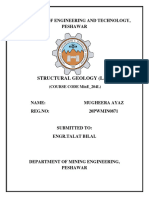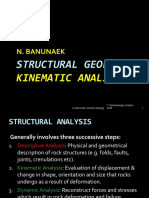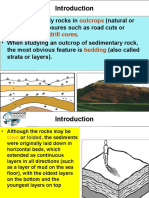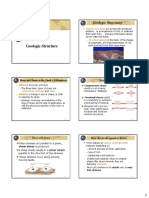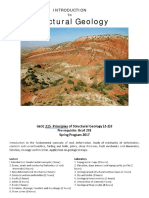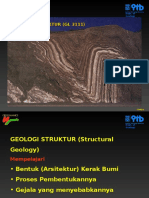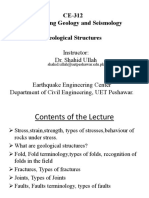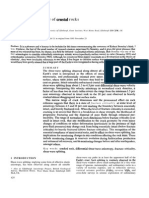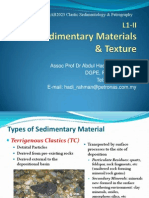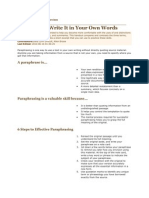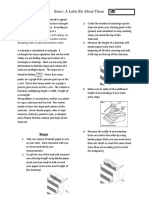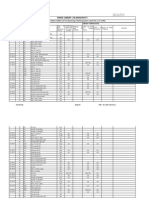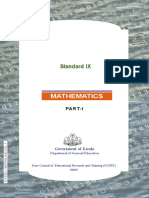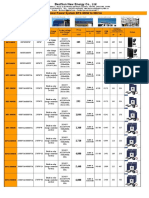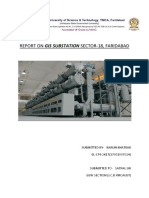Structural Geology QAB1053
Lecture #2
Learning Outcomes
Students should be able to: z Know the most important concept of structural geology. z Differentiate between primary and secondary structures. t t z Understand more on secondary structures that deformed by tectonic processes. z Appreciate the importance and usefulness of structural geology in petroleum geosciences.
1 QAB 1053 Structural Geology 2
Fundamental F d t l of f Geologic G l i Structure
Assoc. Prof. Askury Abd Kadir Geoscience & Petroleum Engineering Department
QAB 1053 Structural Geology
STRUCTURAL ANALYSIS
Generally involves three successive steps:
1. Descriptive Analysis: Physical and geometrical description of rock structures (e.g. folds, faults, joints, crenulations etc). 2 Kinematic 2. Ki ti A Analysis: l i Evaluation E l ti of f displacement di l t & change in shape, orientation and size that rocks undergo as a result of deformation. 3. Dynamic Analysis: Reconstruct forces and stresses which result in rock deformation and failure.
QAB 1053 Structural Geology 3
Fundamental Structure
Three fundamental types of geologic structures: 1. Bed contacts 2. Primary y structures p produced during g deposition or emplacement of rock body. 3. Secondary (tectonic) structures produced by deformation of existing sedimentary, igneous and metamorphic rocks.
QAB 1053 Structural Geology 4
�Bed Contacts
Boundaries separating one unit rock from another, generally in two types. 1. Comformable 2. Unconformable (unconformities) z Angular unconformity z Disconformity z Nonconformity
Conformable bed contacts
z Horizontal contact between rock units with no break in depositional or erosional gaps. z No significant gaps or hiatus in geologic time
QAB 1053 Structural Geology
QAB 1053 Structural Geology
Angular unconformity
Bedding contact which discordantly cuts across older strata. z Discordance: Strata at an angle to each other z Contact is typically an erosional surface.
Disconformity
Erosional gap or hiatus between units without angular discordance, e.g. fluvial channel cutting into underlying sequence of horizontally bedded sequence or channel fill deposit.
QAB 1053 Structural Geology
QAB 1053 Structural Geology
�Nonconformity
Sedimentary strata overlying igneous or metamorphic rocks across a sharp contact, e.g. Pre-Cambrian-Paleozoic contact in Ontario represents an erosional hiatus of 500Ma.
Structural relations
The structural relation between bed contacts are important in determining; z Sequence of events z Relative ages of rock units z Present of tectonic deformation/uplift
QAB 1053 Structural Geology
QAB 1053 Structural Geology
10
Stratigraphic Principles - Recap
These principles covered in physical geology z Principle of original horizontality z Principle of original lateral continuity z Principle of cross-cutting z Principle of inclusion You must always remember: Uniformitarianism the present is the key to the past.
QAB 1053 Structural Geology 11
PRINCIPLE OF ORIGINAL HORIZONTALITY
Sedimentary rocks are deposited as essentially in horizontal layers (Steno, 1600s) z Exception is cross-bedding (delta fore-sets, subkha or sand dune). z Dipping pp g sedimentary y strata implies p tectonic tilting g and/or folding of strata.
QAB 1053 Structural Geology
12
�Principle of original lateral continuity
Sedimentary strata extend as laterally continuous layers in all directions within a basin (Steno, 19600s), until: z They thin and pinch-out z Grade into different type of sediment z Terminate against g the basin edges g or barrier ( (e.g. g shoreline)
Principle of cross-cutting
Igneous intrusions and faults are younger than the rocks they cross-cut (J. Hutton)
sandstone
Mafic dyke
QAB 1053 Structural Geology
13
QAB 1053 Structural Geology
14
Cross-cutting Relations
Often several cross-cutting relationships are present
Principle of inclusion
Inclusions within a host rock are always older than the host (J. Hutton)
Granite inclusions in basalt
How many events can you identify in this outcrop?
QAB 1053 Structural Geology 15 QAB 1053 Structural Geology 16
�Primary Sedimentary Structures
Structures acquired or obtained during deposition of sediments or emplacement of rocks z Horizontal bedding (stratification) is most common structure in sedimentary rocks.
Laminated mudstone
QAB 1053 Structural Geology
17
QAB 1053 Structural Geology
18
Primary Sedimentary Structures
Primary Structures - Fossils
Fossils preserved remains of organisms, casts or moulds z Good strain indicator z Determine strain from change in shape of fossil z Relative change in length of lines/angle between lines.
QAB 1053 Structural Geology
19
QAB 1053 Structural Geology
20
�Primary Igneous Structures
z Pillow lavas - record extrusion and quenching of lava from sea floor, fast cooling effect contact to sea water. z Convex upper surface indicates way up.
Primary Igneous Structures
Flow stratification layering in volcanic rocks produced by the emplacement of successive lava sheets/flows. Stratification of ash (tephra or pyroclastic) layers.
Ash Lava
Pillow lavas forming at MOR
QAB 1053 Structural Geology 21 QAB 1053 Structural Geology 22
Importance of Primary Structures
z Paleocurrent determine paleoflow directions z Origin mode of deposition (slow or fast), environments (terrestrial, transition, marine) z Way-up useful indicators of younging in stratigraphic t ti hi sequence ( (normal l or overturned) t d) z Dating allow relative ages of rocks to be determined based on position, cross-cutting relations and inclusions z Strain indicators deformation of primary structures allows to estimates of rock strain
QAB 1053 Structural Geology 23
Secondary Structures
z Deformation structures produced by tectonic forces and other processes in crust (intrusive), such as:
{Fractures/joints {Faults/Shear zones {Folds {Cleavage/foliation/lineation
z Secondary structures are of primary interest in structural geology
QAB 1053 Structural Geology 24
�Fractures and Joints
z Fractures (general term) surface along which rocks has broken lost cohesion. z Joints (specific) fractures with little or no displacement parallel to failure surface. z Fractured system indicates brittle deformation of brittle b h i behaviour materials. t i l
Faults
Fracture surfaces with appreciable displacement of strata or rock units.
Fractured granite overlain by metasedimentary rocks
QAB 1053 Structural Geology
25
QAB 1053 Structural Geology
26
Shear Zones
Shear zone zone of deformed rock that is more highly strained than surrounding rocks or host rock. z Commonly occurs in middle or lower crust z It can be brittle or ductile deformation
Fault Types
Dip-slip fault slip is parallel to the fault dip direction z Normal fault footwall block displaced up z Reverse (thrust) fault - footwall block displaced down
Ductile shear zone
QAB 1053 Structural Geology
27
QAB 1053 Structural Geology
28
�Fault Types
Strike-slip/lateral fault slip is horizontal or parallel with strike of fault plane. z Right-handed or right lateral fault (dextral) z Left-handed or left lateral fault (sinistral)
Fault Types
Oblique fault combination of dip- and strike-slip motion. z Dextral-normal z Dextral-reverse z Sinistral-normal Sinistral normal z Sinistral-reverse
QAB 1053 Structural Geology
29
QAB 1053 Structural Geology
30
What is the fault type?
Specify the direction of shear
QAB 1053 Structural Geology
31
QAB 1053 Structural Geology
32
�Folds
Warping of strata produced by compressive deformation
Fold Terminology
z Hinge (Axial) plane imaginary plane by bisecting fold limbs z Hinge line trace of axial plane on fold crest z Plunge angle of dip of hinge line
QAB 1053 Structural Geology
33
QAB 1053 Structural Geology
34
Foliation and Cleavage
z Foliation parallel alignment of planar fabric elements within a rock. z Cleavage tendency of rock to break along the planar surface. { Type of foliation { Resemble fractures, but are not physical discontinuity.
Lineations
Subparallel to parallel alignment of elongate of linear fabric elements in a rock bodies, e.g. slickensides and grooves on the fault plane surface.
QAB 1053 Structural Geology
35
QAB 1053 Structural Geology
36
�Think & answer these questions
1. What are the differences between primary and secondary structures? 2. How do you recognise 1o & 2o structures in the mesostructure scale? 3. What is bed contact? Why it is very important in structural geology? 4. Where you always encounter geological hiatus? What elements or features synonym to hiatus?
QAB 1053 Structural Geology 37
CONCLUSION
z The bed contact can be conformable or unconformable. z Stratigraphic principles and uniformitarianism are the most important p rules for better understanding of bed relationship. z Primary structures are very important tool to interpret historical geology. z Secondary structures are deformed structures by tectonic activities.
QAB 1053 Structural Geology 38
10











